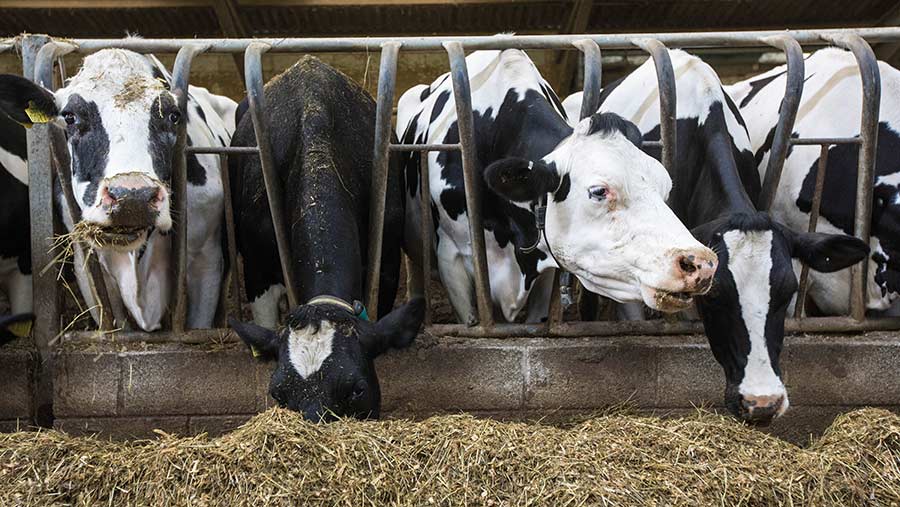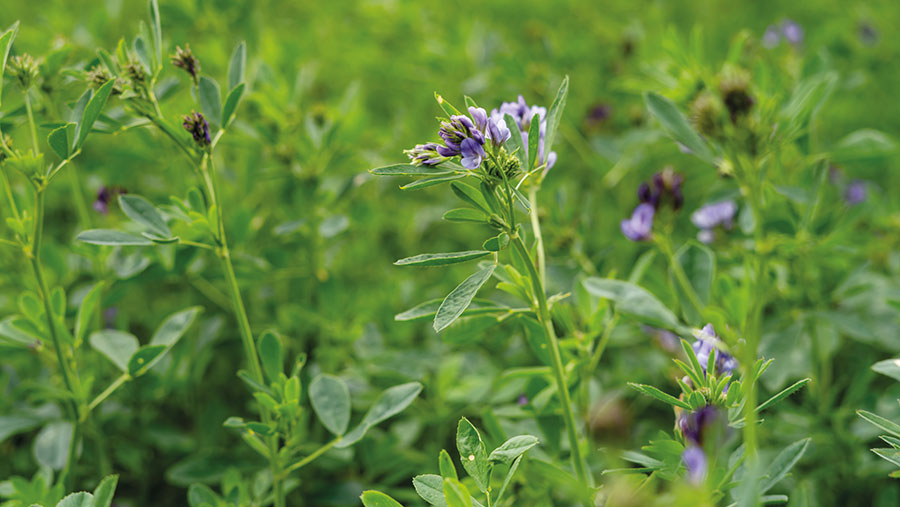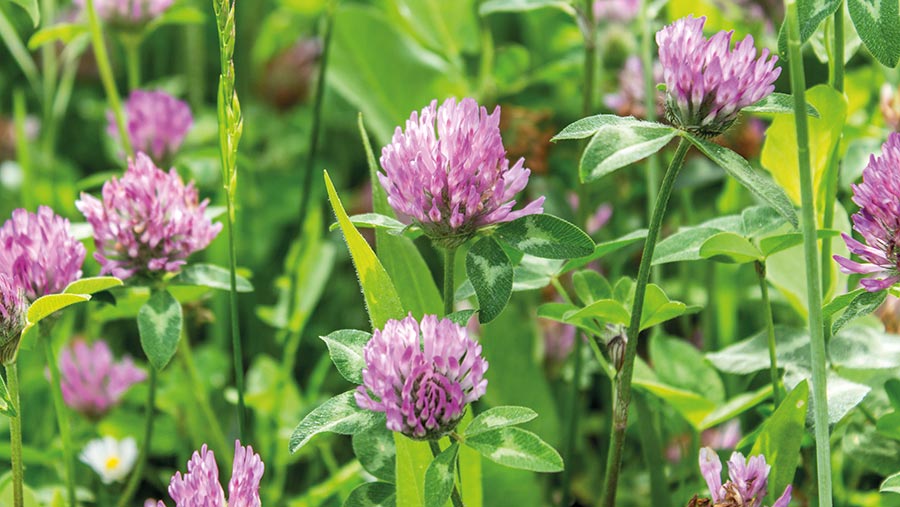How home-grown forages could make dairy protein more green
 © Tim Scrivener
© Tim Scrivener Making better use of home-grown forages could help eliminate the overfeeding of costly dietary protein in dairy cow diets and, in turn, reduce associated emissions, according to Liam Sinclair, professor of animal science at Harper Adams University.
Prof Sinclair recently completed a three-year study, funded by AHDB Dairy, which looked at the potential for lowering protein in diets and using home-grown forages, which are inherently higher in crude protein (CP).
See also: How Cornish farmer cut feed emissions but maintained output
Environmental effects
With the cost of soya high, reducing protein content is financially attractive.
But, away from economics, Prof Sinclair says there are environmental implications associated with feeding high levels of protein – nitrogen and ammonia emissions.
Excess nitrogen excreted by cattle means more N is going back onto grassland, which is a challenge considering many farmers are in nitrate vulnerable zones. Losses also come from urine.
“The Clean Air Strategy is [already] having an effect – and is going to have a greater impact – and really, it relates to ammonia emissions. Cows don’t produce or excrete ammonia, but they do excrete urea – mainly in the urine.
“When this [the urea] comes into contact with muck, it releases ammonia, and that ammonia goes into the atmosphere,” Prof Sinclair says.
“About 88% of ammonia emissions come from agriculture, and about 50% of these come from cattle.”
Tackling these emissions means reducing urea and nitrogen excreted from dairy diets, both of which are associated with insufficient use of protein.
However, with protein being a key driver of yield and quality, there have long been concerns about the effect a reduction in protein may have.
Legume forages
High-protein legume forages such as lucerne and red clover are naturally higher in CP than maize and grass silage, which reduces overall reliance on purchased protein.
They also offer benefits such as fixing nitrogen and drought tolerance, making them a good alternative forage.
The challenge with these forages, however, is that they are also higher in rumen-degradable protein.
This means rations need to be balanced carefully to ensure cows’ metabolisable protein requirements are being met, says Prof Sinclair.
The research
The objectives of this research project were to improve nitrogen use efficiency while maintaining performance, and simultaneously reduce feed costs by feeding low-protein diets based on high-protein, home-grown forage legumes.
The research was broken down into three studies (see “Home-grown protein forages trials results”).
Study 1: Lucerne and varying CP
This study assessed three treatment groups, with cows all fed a lucerne and maize silage diet.
Each diet had the same metabolisable protein content, but differed in CP content, which ranged from 15% to 17.5%.
Each diet was fed for 28 days, and each group of cows received all three diets over the total trial period of 84 days.
Two treatments saw the ratio of lucerne to maize split 50:50 (on a dry matter (DM) basis), while the third (15% CP) was split 60:40 in favour of lucerne.
Parameters including daily milk yield and faecal grab samples were assessed, as well as blood analysis, weight and body condition score (BCS) at the beginning and end of the test period.
Results
Reducing CP content also reduced DM intake slightly, but there was no effect on milk yield, butterfats or protein.
Nitrogen use efficiency was also improved where CP levels were lower.

Lucerne © Adobe Stock
Study 2: Red clover and varying CP
The second study involved feeding red clover-based diets with varying CP levels – again ranging from 15% to 17.5% – to early lactation cows, with each group receiving every diet for 28 days.
Metabolisable protein levels were kept the same in each treatment.
Analysis methods included daily milk yield and daily faecal grab samples, as well as blood samples, weight and BCS at the start and end of the test period.
Results
Milk yield, fat and protein remained similar despite lower CP levels, highlighting the importance of ensuring metabolisable protein requirements are met.
Nitrogen use efficiency was also best in the 15% CP level treatment group.

Clover © Cora Muller/Adobe Stock
Study 3: Low CP
Despite positive results from the first two studies, researchers were concerned that while DM intake of the lower-protein rations was less, milk yield had been retained.
They theorised that cows could be mobilising energy stores to make up that difference, and might not be able to continue to do so in a longer-term study, explains Prof Sinclair.
With this in mind, the final study looked in more detail at BCS and liveweight, and involved feeding groups of cows one of four different rations over a 14-week period, all based on red clover and silage:
- 17.5% CP (control group)
- 15% CP
- 15% CP with added dietary starch
- 15% CP with rumen-protected methionine – an amino acid fundamental in protein production.
The purpose of these final two treatment groups was to explore whether microbial protein yield could be increased, and to improve the amino acid profile of that protein.
As with the previous studies, analysis methods included daily milk yield, but this study also benefited from fortnightly liveweight and BCS measurements, as well as blood samples collected at the start and in week four, eight and the final week of the trial.
At the end of the 14 weeks, urine and faecal samples were collected from five cows selected at random from each treatment group.
Results
Despite the increased study period, lower-protein diets had no significant effect on DM intake and had no negative impact on milk yield, quality or liveweight.
However, Prof Sinclair says it is important not to overdo lowering protein (less than 15% CP) as this could affect long-term performance.
No added benefit was seen where starch and methionine were added.
Liam Sinclair presented his latest research at a recent “Research Roadshow” hosted by AHDB.
Research findings summary
Dietary protein can be cut to 15% crude protein (CP) in rations based on home-grown forage legumes and will not affect performance if metabolisable protein requirements are met.
Other findings
- Feeding very low-protein diets (14% or less) is more likely to reduce performance, although nitrogen use efficiency will be further improved
- Supplementing low-protein diets with rumen-protected amino acids will increase costs, but may not always improve performance
- Cost analysis showed purchased feed cost savings of 0.5-1p/litre can be achieved through lower-protein diets, although more rumen-protected sources will have to be fed, which are more expensive
Source: AHDB
Results of home-grown protein forages trials |
|||||
|
|
Dry matter intake (kg/day) |
Yield (kg/day) |
Fat (%) |
Protein (%) |
Nitrogen use efficiency (%) |
Study 1 |
|||||
|
50% lucerne and 50% maize – 17.5% crude protein (CP)
|
26.2 |
40.9 |
3.8 |
3.1 |
27 |
|
50% lucerne and 50% maize – 15% CP |
24.2 |
39.8 |
3.8 |
3 |
33 |
|
60% lucerne and 40% maize – 15% CP |
25 |
38.9 |
3.9 |
3 |
30 |
Study 2 |
|||||
|
Red clover at 17.5% CP |
25 |
36.1 |
4.1 |
3.2 |
25 |
|
Red clover at 16.5% CP |
25.2 |
37 |
4.3 |
3.2 |
26 |
|
Red clover at 15% CP |
23.5 |
36.8 |
4.3 |
3.2 |
30 |
Study 3 |
|||||
|
Control – 17.5% CP |
22 |
36.3 |
3.9 |
3 |
29 |
|
Low protein – 15% CP |
21.1 |
35.5 |
4.0 |
3 |
34 |
|
Low protein plus starch – 15% CP |
21.7 |
37.4 |
4.1 |
3.1 |
34 |
|
Low protein plus methionine – 15% CP |
21.2 |
36.7 |
4.1 |
3.1 |
35 |
|
Source: Liam Sinclair/Harper Adams University |
|||||
